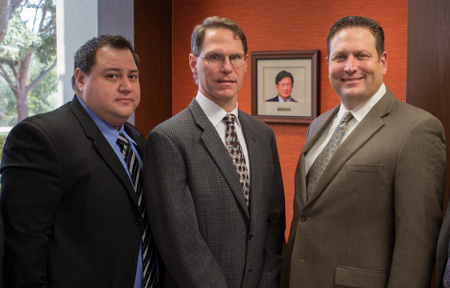K-Cartridge™ Cement Pump Seal Assembly
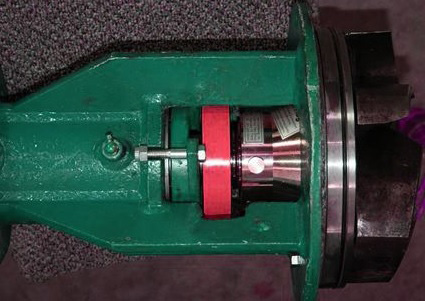
Introduction to the K-Cartridge
The K-Cartridge-brand cement pump seal assembly (Figure 1) uses hydrodynamic seals to address the extreme challenges faced by the mixing and charging pumps of oilfield well-cementing trucks. The cartridge replaces the removable stuffing box on 4 x 5 and 5 x 6 Twentieth Century and Gardner-Denver brand centrifugal pumps. We tested the K-Cartridge with a sand slurry for over 500 hours in the lab and have been selling them to the field since 2005.
As with conventional stuffing-box mounted cement pump seal arrangements, the K-Cartridge is supplied with a pressurized lubricant at ̴60 psi by a conventional air-over-oil lubricator. One lubricator per pump is recommended.
A cross-section of the K-Cartridge is included as Figure 2. Two hydrodynamic cement pump seals contain the pressurized lubricant and two lip-type barrier seals face and contain the cement. One hydrodynamic seal prevents lubricant loss to atmosphere. The other serves as a miniature rotation-driven pump to pressurize, lubricate, and flush the lip seals. All seals run on a hard-coated pump shaft to minimize wear.
A shaft driven fan provides forced air cooling of the cement pump seal assembly. Heat transfer is further augmented by the shape of the housing and its ample contact with the cement-cooled casing of the pump, and by heat draw from the shaft to the cement-immersed impeller of the pump.
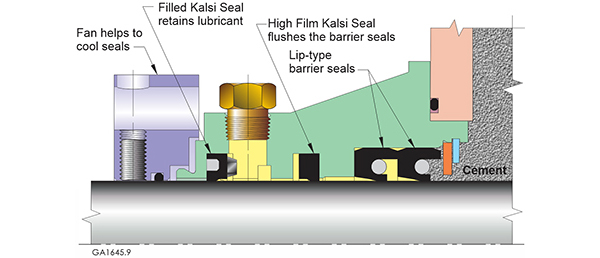
The hydrodynamic cement pump seals
The hydrodynamic cement pump seals that contain the pressurized lubricant are a High Film Kalsi Seal™ and a Filled Kalsi Seal™. Both seals are installed in housing grooves, compressed radially against the pump shaft, and seal statically like other interference-type seals. The dynamic lips of both seals have hydrodynamic waves. When the pump shaft rotates, the seals remain stationary and the sealing interfaces between the seals and the shaft become dynamic. During shaft rotation the hydrodynamic waves force a film of lubricant across the dynamic sealing interfaces. The seals hydroplane on the film as long as shaft rotation continues. This hydroplaning action reduces seal friction, wear, and seal generated heat, prolonging seal life at the relatively high speeds of cement pumps. Both hydrodynamic seals provide a liquid-tight seal in the absence of rotation.
The Filled Kalsi Seal (Figure 3) is located at the air side of the cement pump seal cartridge and prevents the loss of the seal lubricant to atmosphere. It has an annular groove that is filled with a soft energizing material. The construction method reduces the radial cross-sectional tolerance, compared to seals with mechanically retained energizers. This composite construction produces a light lip load that further reduces seal-generated heat – an important attribute at the high rotary speeds of cement pumps. The hydrodynamic waves of the Filled Seal are selected to produce low hydrodynamic pumping related lubricant leakage.
The waves on the High Film™ cement pump seal (Figure 4) have an aggressive design that causes them to have a significant hydrodynamic pumping rate during shaft rotation – a pump rate that provides a metered flushing rate without the need for a troublesome needle valve. The seal acts as a miniature pump to pressurize, lubricate, and flush a pair of more conventional lip type cement pump seals that face the cement-filled volute of the pump. The High Film Seal™ also provides redundancy to the lip seals, in terms of containing the cement slurry.
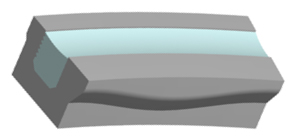
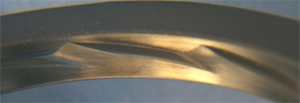
Kalsi Engineering Company Background
The main offices of Kalsi Engineering are in Sugar Land, Texas, which is part of the Houston metropolitan area. We have been serving the oil and gas industry since 1978 with consulting engineering services and rotary shaft seal technology. Company founder M. S. Kalsi, PhD, P.E. became interested in rotary sealing while pursuing his masters and doctorate degrees. His fundamental research produced the lubrication concept used by our cement pump seals. Our commitment to continuing research has produced a variety of advanced rotary shaft seal products with extended performance envelopes. Contact us to discuss your rotary shaft seal requirements.
